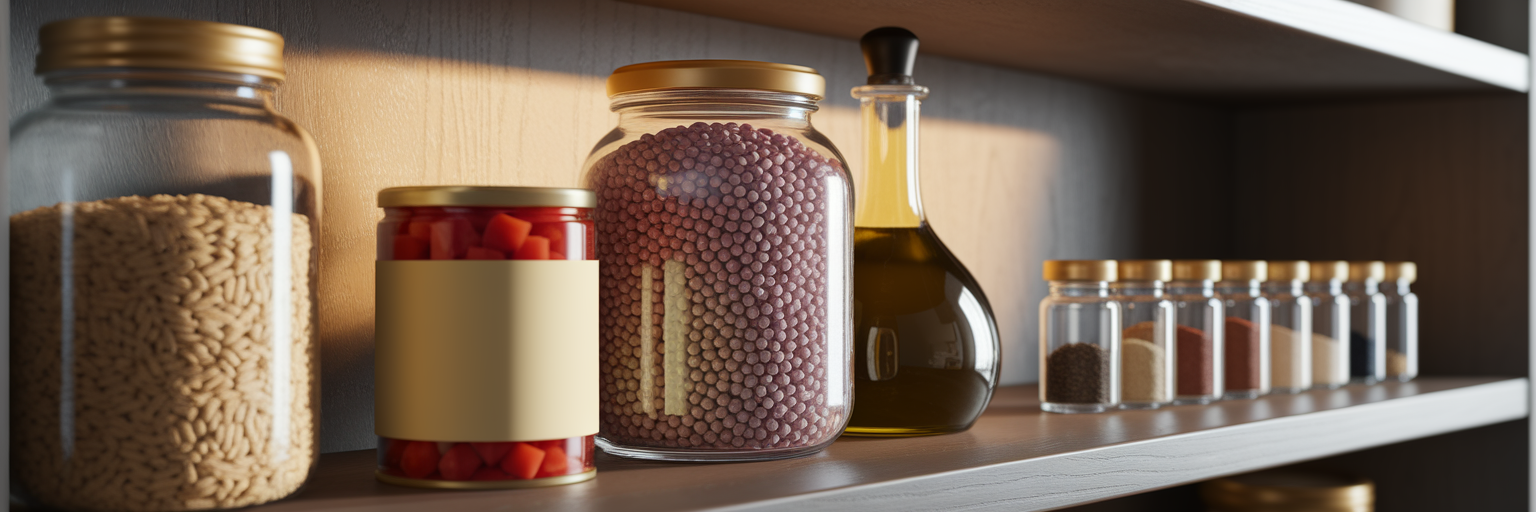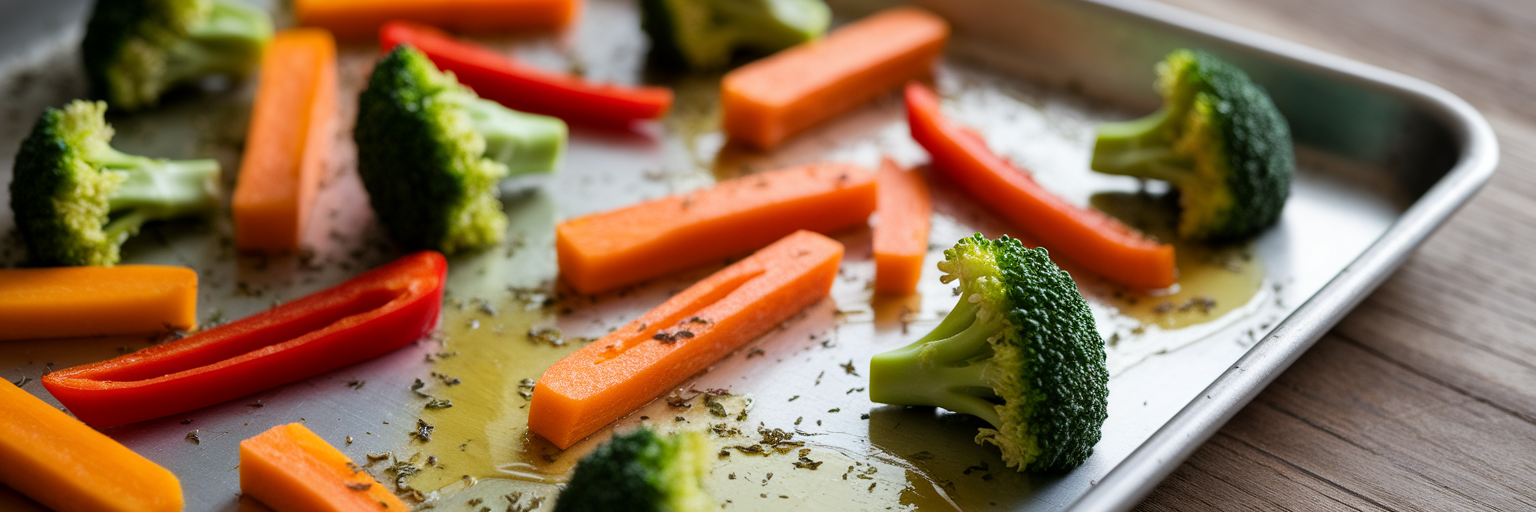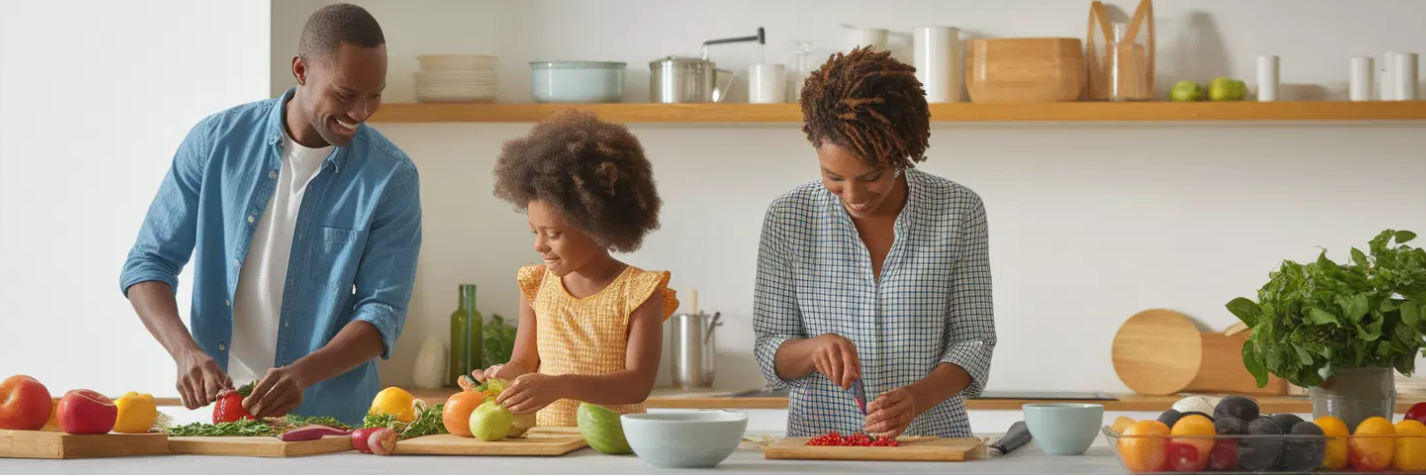It's a common kitchen story: fresh produce wilts in the crisper, and half used jars clutter the fridge. A significant amount of household food waste often stems from these forgotten or unused ingredients, a challenge many home cooks, especially beginners, frequently encounter. This reality highlights a simple truth, learning to cook with what you already have is not just an economical choice, it is also an empowering one that benefits the environment. Mastering the art of cooking with few ingredients can transform kitchen apprehension into creative confidence. This approach forms the heart of our minimalist kitchen guide, designed to help you thrive with less.
Embracing the Minimalist Kitchen
Stepping into the kitchen with only a handful of ingredients might seem daunting at first. However, this approach can unlock a surprising amount of culinary creativity and satisfaction. It is about shifting your perspective from what you lack to the potential held by what you possess.
The Joy of Resourceful Cooking
Resourceful cooking turns limitations into opportunities. When you are cooking with few ingredients, you are not restricted, you are challenged to be inventive. Think of it like a puzzle, where each component must be used thoughtfully to create a cohesive and delicious meal. This process fosters a deeper connection with your food and the cooking process itself. The satisfaction of creating something wonderful from simple items is immense, building a sense of accomplishment that often surpasses following a complex recipe to the letter. It is about discovering the hidden potential in everyday items.
Key Benefits for Novice Cooks
For those new to the kitchen, adopting a minimalist approach offers several practical advantages. Firstly, it is a fantastic way to manage your expenses, directly supporting budget meal ideas by ensuring you use what you buy. Secondly, it significantly helps to reduce food waste cooking, as you become more mindful of your inventory. This practice is not only good for your wallet but also for the planet. Finally, working with fewer components allows you to develop core cooking skills without feeling overwhelmed. These foundational beginner cooking tips build a strong base for more adventurous culinary explorations later on.
Shifting Your Culinary Mindset
Traditionally, many of us learn to cook by following recipes meticulously. While recipes are valuable guides, a minimalist approach encourages an ingredient first mindset. Instead of asking "What recipe can I make?", you start asking "What can I make with the ingredients I have?". This shift is crucial. It cultivates adaptability, enhances problem solving skills in the kitchen, and makes you a more intuitive cook. You learn to trust your instincts and taste, rather than relying solely on written instructions.
How Technology Can Assist
Navigating this new culinary path can be made easier with modern tools. Certain apps are designed to support this very philosophy. For instance, tools like EasyChef can offer suggestions for easy pantry recipes based on the specific ingredients you have on hand. This kind of assistance can be particularly helpful for beginners, taking some of the guesswork out of the initial stages and demonstrating the versatility of their existing supplies. The focus here is on how technology can conceptually support your journey towards resourceful cooking, making the transition smoother and more enjoyable.
Building Your Core Pantry and Fridge
A well stocked yet minimalist pantry and fridge are the bedrock of successful cooking with few ingredients. It is not about having everything, but about having the right things. This section of our minimalist kitchen guide focuses on creating a versatile foundation that allows for maximum flexibility with minimal clutter.
The Power of Versatile Staples
The secret to a functional minimalist kitchen lies in choosing ingredients that are true workhorses. A small, carefully selected array of staples can be combined in countless ways to produce a wide variety of meals. This understanding is key before you even begin to list items. Many culinary experts, like those at BBC Good Food, often highlight a core list of versatile ingredients that form the backbone of any efficient kitchen, proving that less can indeed be more when it comes to pantry planning.
Essential Non-Perishable Items
These are the items that form the bulk of many easy pantry recipes and offer long lasting value:
Rice and Pasta: Fundamental bases for countless dishes, providing carbohydrates and substance.
Oats: Perfect for breakfasts, but also useful as a thickener or binder.
Canned Chickpeas and Lentils: Excellent sources of plant based protein, ready to be added to salads, stews, or curries.
Canned Diced Tomatoes: The foundation for numerous sauces, soups, and stews, offering acidity and depth.
Coconut Milk: Adds creaminess and richness to curries, soups, and even desserts.
Canned Tuna or Salmon: Quick protein for salads, sandwiches, or pasta dishes.
Olive Oil and Vinegar: Essential for cooking, dressings, and adding brightness to flavours.
Basic Spices (Salt, Pepper, Garlic Powder, Onion Powder, Mixed Herbs): The building blocks of flavour for almost any savoury dish.
Key Long-Lasting Fresh Ingredients
While non perishables are crucial, some fresh items have a good shelf life and offer immense versatility:
Onions and Garlic: Aromatic bases for a vast majority of savoury dishes.
Potatoes and Carrots: Hardy root vegetables that can be roasted, boiled, mashed, or added to stews.
Eggs: A versatile protein source for any meal of the day.
Hard Cheese (e.g., Parmesan, Cheddar): Adds flavour and can last a long time when stored properly.
Smart Shopping for a Minimalist Pantry
Stocking your pantry efficiently involves more than just buying items, it requires a strategic approach. One of the most effective beginner cooking tips is to buy appropriate quantities. Avoid bulk buying perishable items unless you have a clear plan to use them. Prioritize multi use ingredients, those that can play a role in several different types of meals. Keep an eye out for sales on your core staples, which can significantly help with budget meal ideas. This thoughtful approach to shopping ensures your pantry supports your cooking goals without leading to clutter or waste.
| Ingredient Category | Examples | Key Uses & Versatility | Storage Tip |
|---|---|---|---|
| Grains & Pasta | Rice, Pasta, Oats, Quinoa | Energy source, meal base, thickener (oats) | Airtight containers, cool, dark place |
| Legumes (Canned/Dried) | Chickpeas, Lentils, Black Beans | Plant-based protein, bulk for stews/salads, dips | Canned: cool, dark. Dried: airtight containers |
| Canned Goods | Diced Tomatoes, Coconut Milk, Tuna/Salmon | Sauce bases, curries, quick protein, soups | Cool, dry pantry; check expiry dates |
| Oils & Vinegars | Olive Oil, Vegetable Oil, Apple Cider Vinegar, White Wine Vinegar | Cooking medium, dressings, marinades, flavour balance | Cool, dark place; tightly sealed |
| Aromatics & Spices | Onions, Garlic, Salt, Black Pepper, Paprika, Cumin, Mixed Herbs | Flavour foundation, seasoning, depth | Garlic/Onions: cool, dark, airy. Spices: airtight, away from heat/light |
| Long-Lasting Produce | Potatoes, Carrots, Apples | Side dishes, meal fillers, snacks | Potatoes/Carrots: cool, dark, ventilated. Apples: fridge for longer life |
Mastering Basic Ingredient Substitutions
Once your pantry is thoughtfully stocked, the next step in becoming proficient at cooking with few ingredients is learning the art of substitution. This skill is incredibly empowering for beginner cooking tips, as it frees you from the rigid confines of a recipe and allows you to adapt based on what you have available. It is a cornerstone of resourceful cooking and a great way to reduce food waste cooking.
Why Substitutions Empower Beginner Cooks
Think of recipes not as strict commands, but as flexible guidelines. Understanding how to make smart substitutions can save a meal when you are missing a specific item. More importantly, it builds your confidence and culinary intuition. Instead of panicking when an ingredient is unavailable, you will feel equipped to find a creative solution. This adaptability is key to enjoying the cooking process and making the most of your resources. It is about making the recipe work for you, not the other way around.
Common Protein Alternatives
Proteins are often central to a meal, but they can frequently be swapped. Here are a few examples:
For Chicken: Canned chickpeas or firm tofu can often work well in stir fries, curries, or salads. Consider the texture and adjust cooking times accordingly.
For Ground Meat: Cooked lentils or finely chopped mushrooms can provide a similar texture and earthiness in sauces or fillings.
For Fish: Depending on the dish, other types of seafood or even marinated tofu can be used.
Vegetable Versatility and Swapping
Many vegetables share similar characteristics and can be interchanged, especially in cooked dishes. This is where your easy pantry recipes can truly shine with flexibility.
Leafy Greens: Spinach can often be used in place of kale, and vice versa, though cooking times might vary slightly. Swiss chard is another versatile green.
Root Vegetables: Carrots, parsnips, and sweet potatoes can often be swapped, especially when roasting or adding to stews.
Cruciferous Vegetables: Broccoli and cauliflower can frequently stand in for one another.
When substituting vegetables, always taste and adjust seasonings as needed, as each vegetable has its own unique flavour profile.
Flavor Boosters: Herb, Spice, and Acid Swaps
Flavor is paramount, and knowing how to substitute herbs, spices, and acidic elements can elevate your dishes. A general rule for herbs is that 1 teaspoon of dried herbs is roughly equivalent to 1 tablespoon of fresh herbs. If a recipe calls for lemon juice to add brightness, a splash of vinegar (like apple cider or white wine vinegar) can often achieve a similar effect. Do not be afraid to experiment with different spice combinations based on what you have. This is crucial for making cooking with few ingredients truly delicious.
Understanding Substitution Limits
While substitutions are powerful, it is important to offer a balanced perspective. Some ingredients, particularly in baking (like flour or leavening agents), play critical chemical roles and cannot be easily swapped without affecting the outcome. Similarly, certain signature ingredients in specific ethnic dishes define the dish's character and might be difficult to replace authentically. For beginners, it is wise to start with simpler substitutions in savoury dishes before tackling more complex ones.
Simple Cooking Techniques for Maximum Flavour
Having the right ingredients and knowing how to substitute them are vital skills. However, the techniques you use to cook those ingredients are what truly bring out their best. This section focuses on foundational cooking methods ideal for cooking with few ingredients, ensuring that even simple components can yield incredibly flavourful results. These are essential beginner cooking tips for creating satisfying meals with minimal complexity.
The Magic of One-Pan and One-Pot Meals
One pan and one pot meals are champions of simplicity and flavour. They minimize cleanup and allow ingredients to meld together beautifully. These methods are perfect for crafting easy pantry recipes. Here are a few starting points:
Basic Stir Fries: Combine your choice of vegetables and a protein (like chicken, tofu, or shrimp) with a simple sauce. Everything cooks quickly in one wok or large skillet.
Sheet Pan Dinners: Toss chopped vegetables and a protein (like sausages or chicken pieces) with oil and seasonings, then roast on a single baking sheet.
Simple One Pot Pastas: Cook pasta, sauce, and sometimes even vegetables together in one pot for a cohesive and flavourful dish.
For more inspiration on one pot wonders, resources like Taste of Home's collection offer excellent starting points and showcase the versatility of this technique.
Fundamental Sautéing for Flavor Building
Sautéing is a core skill that forms the flavour base for countless dishes. It typically starts with gently cooking aromatics like chopped onions, garlic, or celery in a bit of oil or butter. This process softens them and releases their foundational flavours. From this base, you can add other ingredients like vegetables, proteins, or spices, building layers of taste. Mastering a simple sauté is a game changer for any home cook.
Roasting for Enhanced Depth and Sweetness
Roasting is a wonderfully straightforward technique that can transform humble ingredients. Simply tossing vegetables or proteins with a little oil, salt, and pepper and then cooking them in a hot oven brings out their natural sweetness and creates a delicious caramelization. Root vegetables like carrots and potatoes, cruciferous vegetables like broccoli and Brussels sprouts, and even fruits like apples or pears become intensely flavourful when roasted. It is a mostly hands off method that delivers impressive results.
Crafting Easy Sauces from Scratch
A good sauce can tie a meal together, and many simple sauces can be made from pantry staples. This ability greatly enhances budget meal ideas by adding variety and richness without expensive store bought options.
Quick Tomato Sauce: Sauté garlic in olive oil, add canned diced tomatoes, season with herbs, salt, and pepper, and simmer.
Basic Vinaigrette: Whisk together olive oil, vinegar (like red wine or apple cider), a touch of mustard, salt, and pepper for a simple salad dressing.
Yogurt Tahini Sauce: Combine plain yogurt, tahini, lemon juice, garlic, and water for a creamy sauce perfect for bowls or roasted vegetables.
Basic Principles of Flavour Layering
Even with few ingredients, you can create complex flavours by understanding layering. Start with aromatics (onion, garlic) to build a base. "Bloom" your spices by adding them to hot oil for a moment to release their fragrance before adding other ingredients. Aim for a balance of tastes: sweet (a pinch of sugar, honey, or sweet vegetables), sour (vinegar, lemon juice), salty (salt, soy sauce), and savory (umami rich ingredients like mushrooms or tomato paste). Finally, adding a fresh element at the end, like chopped herbs or a squeeze of citrus, can brighten the entire dish.
Smart Meal Creation and Reducing Kitchen Waste
The journey of cooking with few ingredients culminates in developing sustainable habits that make meal creation enjoyable and efficient. This final section of our minimalist kitchen guide focuses on ongoing strategies for smart meal planning, effective ingredient use, and minimizing what ends up in the bin, reinforcing both reduce food waste cooking and savvy budget meal ideas.
Creative 'Use-It-Up' Meal Strategies
One of the most satisfying aspects of resourceful cooking is transforming leftovers or ingredients nearing their end into something new and delicious. Instead of seeing a few remaining vegetables or a bit of cooked protein as a problem, view them as an opportunity. Consider these flexible dishes:
Frittatas or Omelettes: Perfect for using up small amounts of cooked vegetables, cheese, and meats.
Soups and Stews: Almost any vegetable or leftover cooked grain or protein can be added to a flavourful broth.
Fried Rice or Quinoa Bowls: Excellent for incorporating leftover rice or quinoa along with various veggies and a protein.
Quesadillas or Wraps: A great way to use up small bits of cheese, beans, cooked chicken, or vegetables.
Ingredient-First Meal Planning
Shift your meal planning approach to start with what you already have. Before heading to the grocery store or even looking up recipes, take stock of your pantry, fridge, and freezer. Identify ingredients that need to be used soon. Then, build your meals around these items. This ingredient first method is a core tenet of the minimalist kitchen guide and ensures you are consistently using your inventory, which is key to reduce food waste cooking.
Effective Ingredient Storage for Extended Freshness
How you store your ingredients significantly impacts their lifespan, which is crucial when you are focused on cooking with few ingredients. For leafy greens, wash and dry them thoroughly, then store them wrapped in a paper towel inside a container or bag in the crisper drawer. Keep herbs fresh longer by trimming the stems and placing them in a jar with a little water, like a bouquet, or by wrapping them in a damp paper towel. Root vegetables like potatoes and onions should be stored in a cool, dark, and airy place, but keep onions away from potatoes as they can cause a_lot_of_spoilage_faster. These simple storage habits can make a big difference.
Embracing the Learning Curve
Becoming a confident and resourceful cook takes time and practice. Do not be discouraged by occasional missteps, they are part of the learning process. Every meal you prepare, every substitution you try, and every new technique you experiment with builds your kitchen intuition. The goal is not just to follow recipes, but to understand ingredients and how they work together. Enjoy the journey of discovery. As you grow more confident, resources like the cook.aizdzj can continue to provide inspiration and practical solutions for your ingredient first adventures, helping you make the most of what you have on hand.











